Sarsa – A Native Recipe of Romblon: Traditional Flavors Explained
Sarsa is a beloved native dish from Romblon, a picturesque island province in the Philippines known for its rich culinary traditions. The dish features small shrimp mixed with young coconut and chili, wrapped in coconut leaves for a truly authentic flavor. What makes Sarsa unique is its exclusive availability in Romblon, making it a must-try for any food enthusiast visiting the region.
Visitors often enjoy Sarsa paired with rice, enhancing the delicate flavors of the dish. The shrimps are typically gathered from local streams, ensuring the freshness and quality of each bite. Such local ingredients not only highlight the traditional Filipino cuisine but also the sustainable practices of the Romblon community.
During my recent trip to Romblon, I had the honor of serving as a judge for the Sarsa Cooking competition. The experience was absolutely wonderful. I was captivated by a simple yet delightful recipe that turned out to be just one among the numerous Sarsa variations. It was astonishing to discover that each town in Romblon has its distinct method of preparing Sarsa, with unique and local ingredients.
The Origins Of Sarsa
Sarsa is a local dish from Romblon, an island province in the Philippines. This unique recipe reflects the rich cultural history of the region.
The usual recipe uses small shrimp caught in local streams, mixed with young coconut and chili. This combination gives Sarsa its distinctive flavor and texture, setting it apart from other dishes.
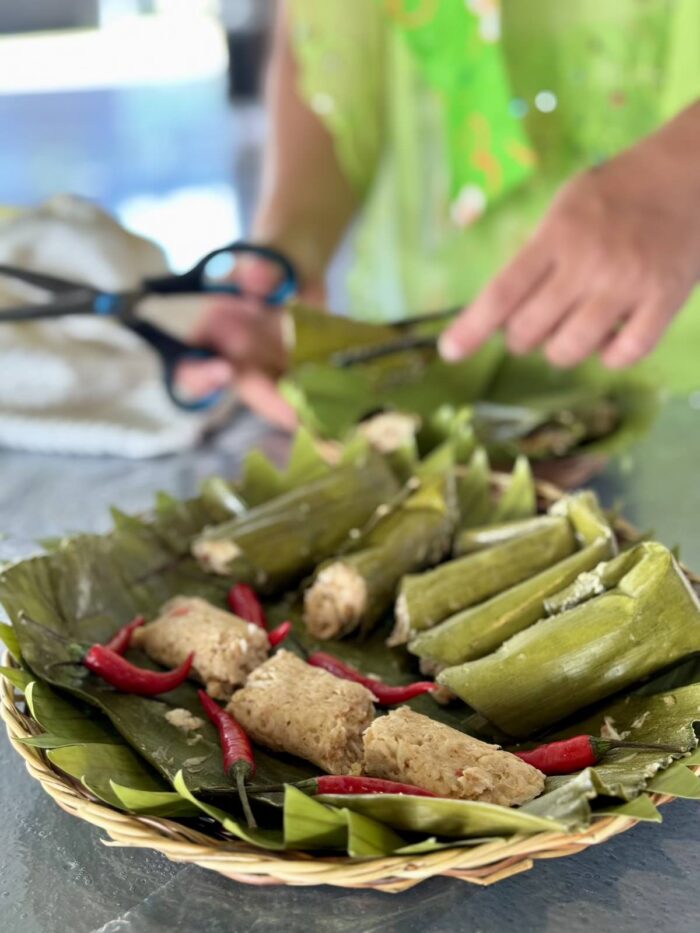
Locally, food holds significant cultural importance. Dishes like Sarsa showcase the traditional culinary practices and ingredients that have been passed down through generations. Families and communities often gather to prepare and enjoy such meals, fostering a sense of unity and heritage.
Sarsa is not just a meal but a representation of Romblon’s agricultural and fishing traditions. Shrimp, an abundant resource, is a staple in the island’s cuisine. The use of coconut and chili also reflects the island’s tropical climate and fertile land.
In Romblon, food markets often sell traditional dishes like Sarsa in the early morning. Visitors are encouraged to try this unique delicacy while it is still fresh. This practice highlights how intertwined food is with daily life and local customs.
Emphasizing local ingredients and traditional methods, Sarsa exemplifies Romblon’s culinary heritage. The dish celebrates the island’s natural resources and the skill of its inhabitants in creating flavorful, meaningful meals.
Sarsa Ingredients Breakdown
Sarsa, a traditional dish from Romblon, combines fresh seafood with a rich coconut base and bold spices. This section explores the main ingredients and their roles in creating the unique flavor of Sarsa.
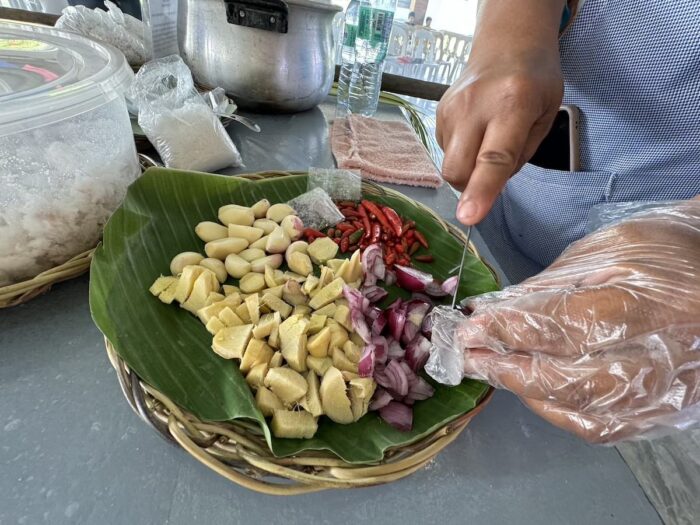
Coconut Milk: The Creamy Base
Coconut milk is the creamy foundation of Sarsa. Made by squeezing grated coconut, it’s rich and adds a smooth texture to the dish.
In Sarsa, coconut milk balances the heat from chilis and spices. It’s usually added towards the end of cooking to prevent curdling and retain its creamy consistency. Using fresh coconut milk instead of canned is preferred for a more authentic taste.
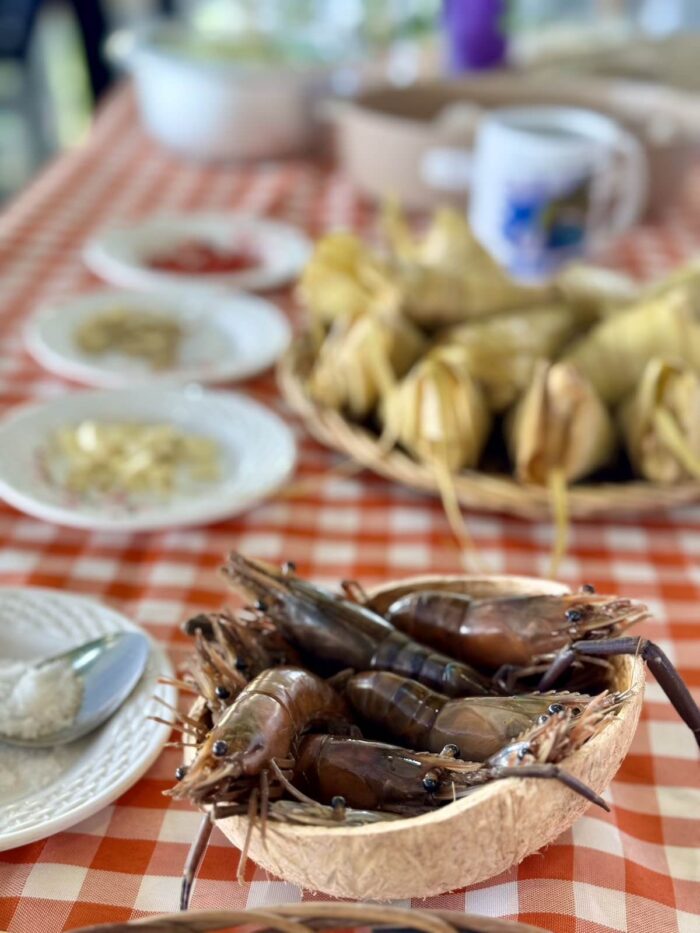
Seafood Variations in Sarsa
Seafood is the star of Sarsa. The dish often uses freshwater shrimp, known locally as “uyang or ulang”. These small shrimp are common in Romblon’s streams.
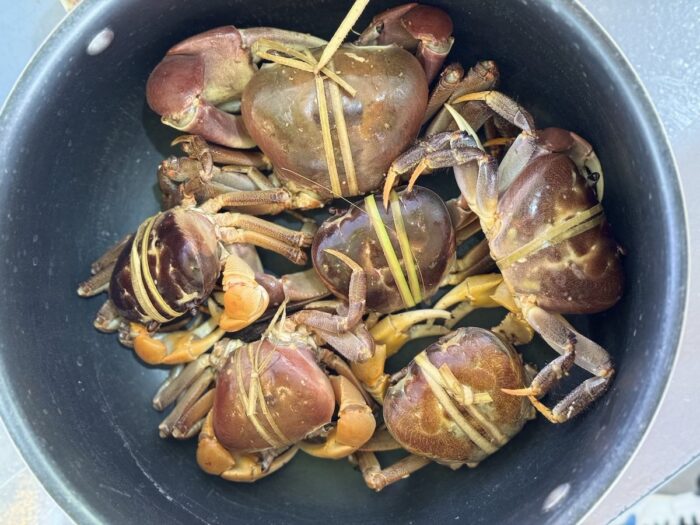
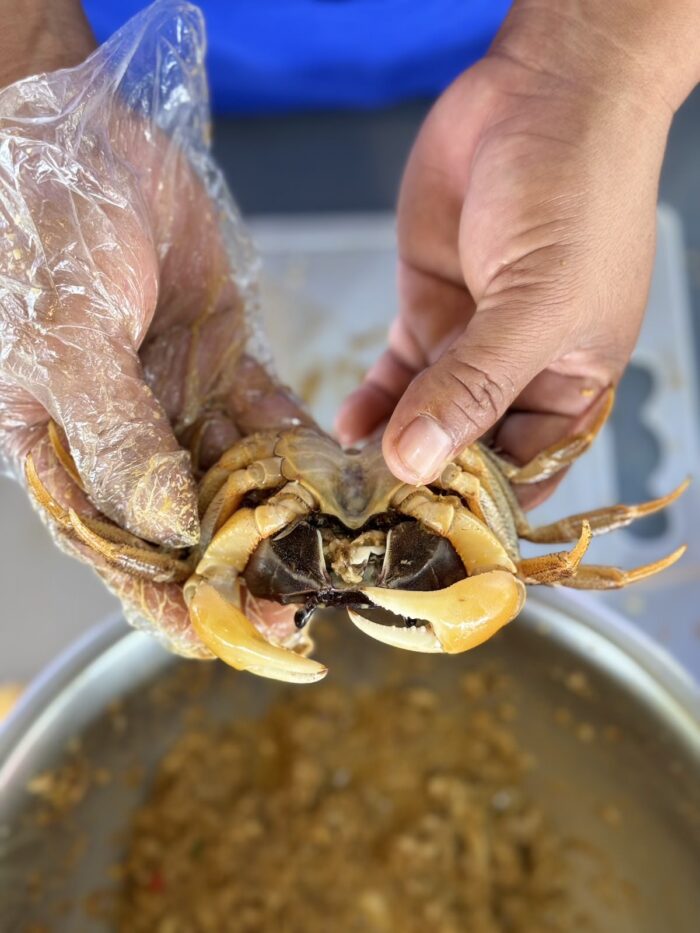
Other variations might include small fish, crabs, kuray or land crabs, but shrimp remains the favorite. The seafood is usually simmered in the coconut milk, absorbing the flavors of the spices and creating a harmonious blend of tastes.
Herbs and Spices: Flavor Essentials
Herbs and spices are crucial to the flavor profile of Sarsa. Ginger, garlic, and onion form the basic aromatic trio. These are typically diced and sautéed to release their flavors into the dish.
Chili peppers, particularly “sili labuyo,” add heat. Peppercorns and salt enhance the other ingredients without overpowering them. These spices, combined with the coconut milk and seafood, create a balanced and flavorful dish that’s unique to Romblon.
Sarsa Preparation Techniques
Traditional Cooking Methods
In Romblon, preparing Sarsa often involves wrapping the mixture in coconut leaves. This process starts with gathering small shrimp from local streams. The shrimp are mixed with grated young coconut and chopped chilies.
- Ingredients:
- Small shrimp
- Young coconut (grated)
- Chilies (usually sili labuyo)


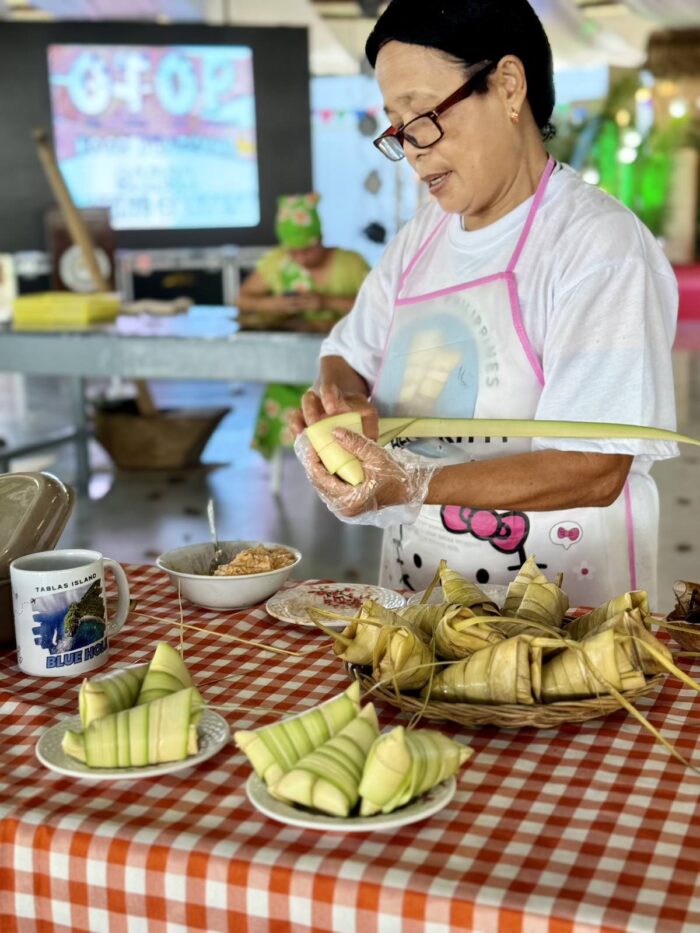
The ingredients are combined and seasoned with salt. The mixture is then neatly wrapped in coconut leaves. These wraps are placed on a charcoal grill or boiled in coconut milk. This technique infuses the dish with a smoky flavor or a creamy texture, depending on the method used.
Modern Adaptations
More modern approaches to making Sarsa simplify the cooking process by using kitchen appliances. Instead of wrapping the shrimp mixture in coconut leaves, cooks might blend the ingredients in a food processor to form a paste.
- Process:
- Blend shrimp, coconut, and chilies into a paste
- Cook the mixture in a pan with oil and coconut milk
Some variations include adding garlic, ginger, and onions for extra flavor. These ingredients are sautéed before mixing in the shrimp and coconut paste. Modern cooks may also serve Sarsa as a sauce over rice or noodles, highlighting its versatility in more contemporary dishes.
Recipes and cooking styles vary, but the essence of Romblon’s local cuisine remains in each adaptation. Whether using traditional methods or modern techniques, Sarsa continues to be a beloved dish that showcases the rich culinary heritage of the region.
Regional Varieties of Sarsa
Sarsa, a beloved dish in Romblon, has several regional variations. These variations showcase the unique ingredients and cooking methods from different parts of the province.
Sarsa Na Ulang and Its Variants
Sarsa Na Ulang is a traditional Romblon dish featuring ulang or uyang, which are freshwater shrimps. The dish combines these shrimp with grated young coconut, chili, and coconut milk for a rich blend of flavors.
In some areas, Sarsa Na Ulang might include other local seafood like Sihi Shell or river-caught prawns. Different families may add their twist, such as using ginger or white onion. These variations offer a subtle yet distinct taste, making each version unique.
Local recipes occasionally replace ulang/uyang with other freshwater shrimp or small prawns, maintaining the core ingredients but allowing flexibility based on available seafood. The key is in the coconut milk and grated coconut, which create a luscious, flavorful base.

Sarsa na Uyang Recipe of San Agustin, Romblon
Ingredients:
- 1 cup peeled and deveined freshwater shrimp
- 2 cups shredded young coconut
- 1 spoon peeled and chopped garlic
- teaspoon small red chillies
- 1/2 teaspoon salt
- 1 cup water
- 5-10 coconut leaves (wrapper)
Cooking Instructions:
- pound all the ingredients in a wooden lusong
- wrap the pounded ingredients in coconut leaves
- Boil in coconut milk
Combi and Other Romblon Delicacies
Apart from Sarsa, Romblon is rich in a variety of other dishes. Combi, a popular dish, is often made with a mix of seafood and vegetables. Ingredients like freshwater shrimp and prawns might be incorporated, showcasing the island’s diverse marine life.
Taghilaw and Gayabon are other cherished delicacies cooked with a range of local spices. Inaslum involves sour yet savory flavors, often paired with fish or shellfish. Ginataang Langka, which uses jackfruit and coconut milk, can also include shrimp or other seafood.
These dishes demonstrate the region’s culinary diversity and deep connection to its local cuisine. Each dish reflects the unique blend of ingredients found in Romblon, offering a taste of the province’s rich food heritage.

Culinary Tourism in Romblon
Exploring Local Eateries
Romblon’s local eateries highlight the island’s rich culinary heritage. Restaurants here often source ingredients locally, ensuring fresh and flavorful dishes. Popular spots serve local specialties like “Sarsa,” a dish made with small shrimp, young coconut, and chili.
One must-visit place is Romblon Deli, known for its fresh seafood. Another is Luzon’s Kitchen, where traditional Filipino food is prepared with a Romblon twist. Visitors should also check out beachside cafes that offer stunning views along with tasty meals.
Cooking Classes and Food Tours
For those who want a more hands-on experience, visit the municipality of romblon during fiesta’s where cooking competitions are held. These cooking competitions typically teach participants how to prepare traditional dishes using local ingredients. Participants can learn to cook “Sarsa” and other local delicacies from experienced chefs.
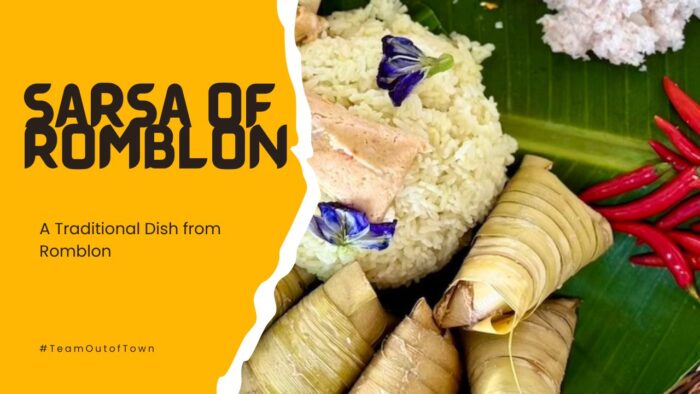
Frequently Asked Questions
How do you prepare the traditional Sarsa dish from Romblon?
To prepare traditional Sarsa, gather small freshwater shrimp, young coconut, and chilies. Clean and dice the shrimp, then mix with grated coconut and sliced chili peppers. Wrap the mixture in coconut leaves and steam until cooked. Serve hot, often paired with rice.
What are the unique ingredients found in Romblon’s Sarsa recipe?
Romblon’s Sarsa includes freshwater shrimp, sliced ginger, diced white onion, sili labuyo (small hot peppers), grated niyog (coconut), and coconut milk. Some variations may use prawns or land crabs instead of shrimp.
What is the history behind the Sarsa recipe in Romblon culture?
Sarsa originates from Romblon where it has been a staple for generations. The dish showcases the island’s abundant natural resources, such as coconut and freshwater shrimp. It is a symbol of the local community’s connection to their environment and traditional cooking methods.
How does Sarsa from Romblon differ from other Filipino foods?
Sarsa is distinct in its use of freshwater shrimp and coconut, giving it a unique flavor profile different from many other Filipino dishes. It is typically wrapped in coconut leaves, which also differentiates it visually and adds a distinct taste when steamed.
Can you recommend any variations of the Sarsa recipe for special diets?
For a vegetarian version, replace shrimp with chopped vegetables like carrots and mushrooms. To make it vegan, ensure no animal products are used, and substitute the patis (fish sauce) with a plant-based alternative. Low spice variations can omit the sili labuyo for a milder dish.
Are there any cultural significances associated with Sarsa in Romblon festivities?
Sarsa plays a role in Romblon’s local festivities. It is commonly prepared during special occasions and communal gatherings, highlighting its importance in cultural and social rituals. The dish signifies community and the sharing of traditional culinary practices, preserving Romblon’s heritage.
Follow and Subscribe to OutofTownBlog.com on Facebook, Twitter, Instagram, Pinterest, and YouTube for more Romblon Tourist Attractions.
Read:
